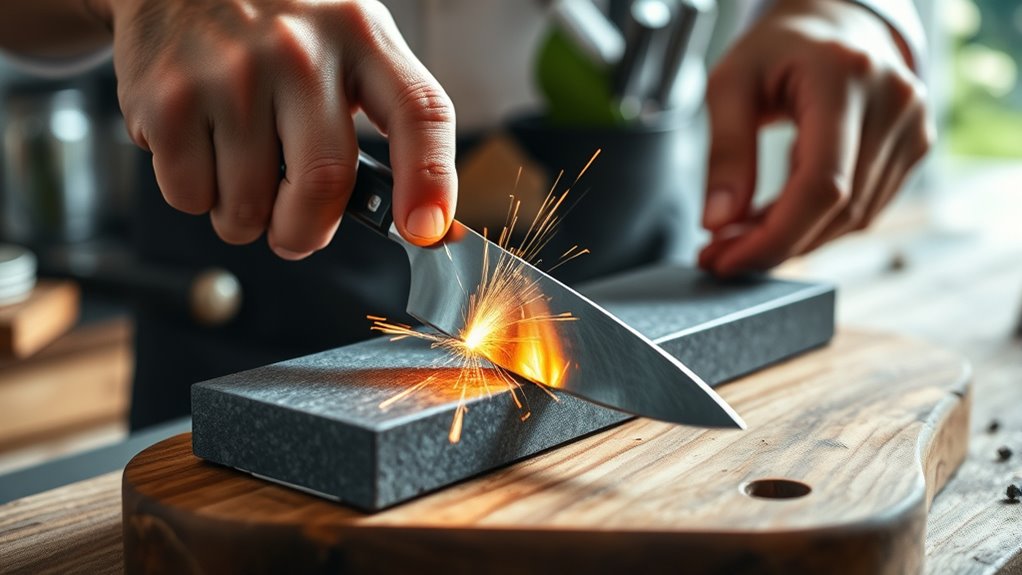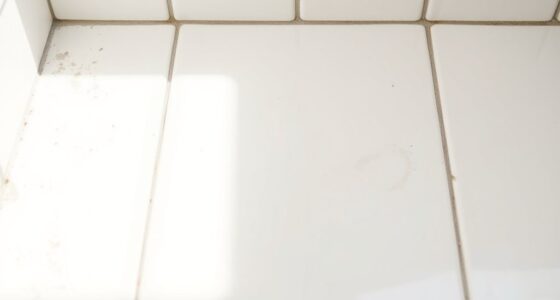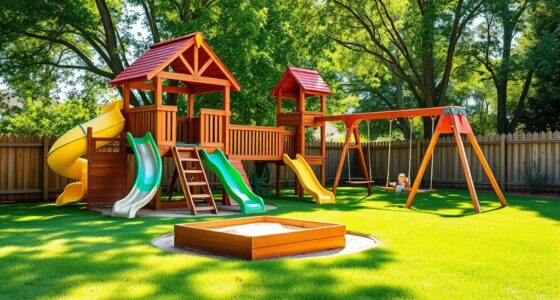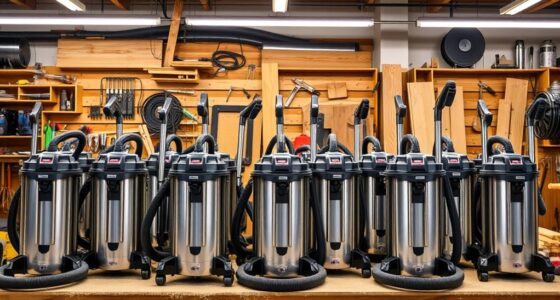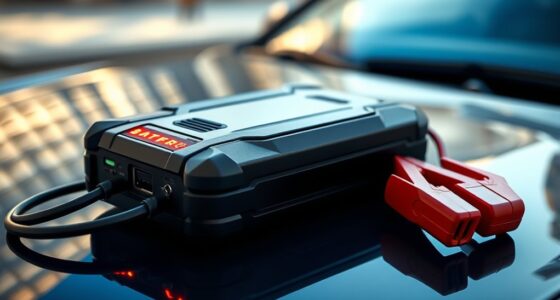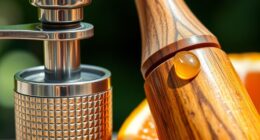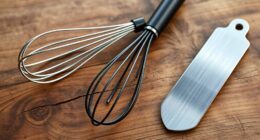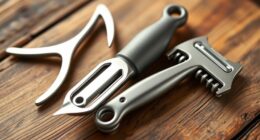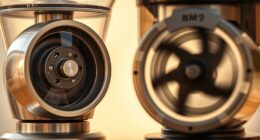To sharpen your knives like a chef, start by honing regularly to keep the edge aligned and maintain sharpness—use a steel or ceramic rod with gentle strokes. When your knife feels dull or cuts poorly, it’s time to sharpen, removing metal on a whetstone or electric sharpener. Learning the proper techniques for each ensures your knives stay in top shape—continue exploring how to master these skills effectively.
Key Takeaways
- Honing realigns microscopic teeth to maintain a sharp edge, performed regularly to prevent dullness.
- Sharpening removes metal to create a new, razor-sharp edge, typically done every 6-12 months.
- Use a honing steel daily for routine maintenance; sharpen with whetstones or electric tools for deep dullness.
- Maintain proper angles (~20°) during both honing and sharpening for optimal edge performance.
- Regularly test sharpness with paper or tomato slices to decide if honing or sharpening is needed.
What Is Honing and Why Is It Important?

Honing is a maintenance process that helps keep your knife’s edge aligned and sharp. When you hone your knives regularly, you ensure the microscopic teeth on the blade stay properly positioned, which maintains a sharp edge. Unlike sharpening, honing doesn’t remove metal; it simply straightens and smooths the existing edge, preventing dullness. Using a honing steel or rod before each use is effective for realigning the blade and maintaining ideal cutting performance. This simple step prevents minor misalignments caused by everyday use from turning into dullness. Proper honing extends the lifespan of your knives and keeps them performing at their best. By routinely honing your knives, you avoid the need for frequent sharpening and guarantee your blades stay sharp longer.
The Sharpening Process: Restoring Your Blade’s Edge
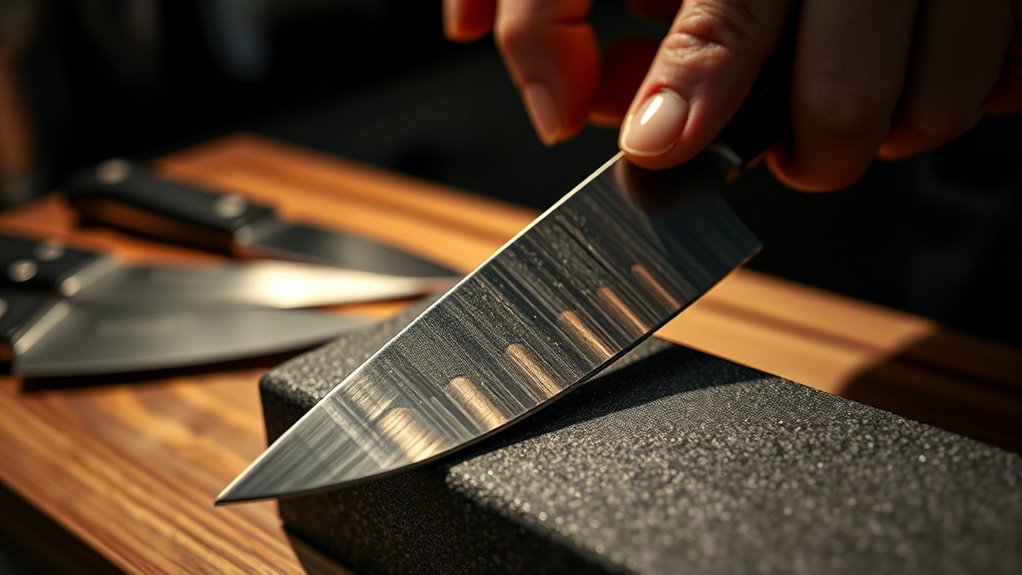
When your knife becomes dull and less effective, sharpening is the crucial process that restores its cutting power. The sharpening process involves removing a thin layer of steel from the blade using a whetstone, electric sharpener, or similar tool. This creates a new, razor-sharp edge by grinding away dullness and imperfections. Proper sharpening requires maintaining an appropriate angle, usually around 20 degrees, to ensure a precise and durable blade edge. Remember, regular sharpening not only improves cutting performance but also extends your knife’s lifespan. Here are the key steps:
- Use the correct sharpening tool for your knife.
- Maintain the proper angle throughout the process.
- Remove material gradually until the blade is sharp again.
- Consistent maintenance ensures the blade stays in optimal condition and reduces the frequency of intensive sharpening sessions. This routine is essential for effective knife maintenance and peak performance. Sharpening is a specific process that differs from honing, which realigns the edge without removing material. Additionally, understanding bicycle tire longevity can help in maintaining your equipment in top condition, just as maintaining a sharp knife ensures optimal performance, and selecting the right tuning modifications can optimize your vehicle’s performance.
A well-maintained blade also benefits from proper cleaning techniques, which prevent rust and corrosion, ensuring the edge stays sharp longer.
Comparing Honing and Sharpening: Key Differences Explained
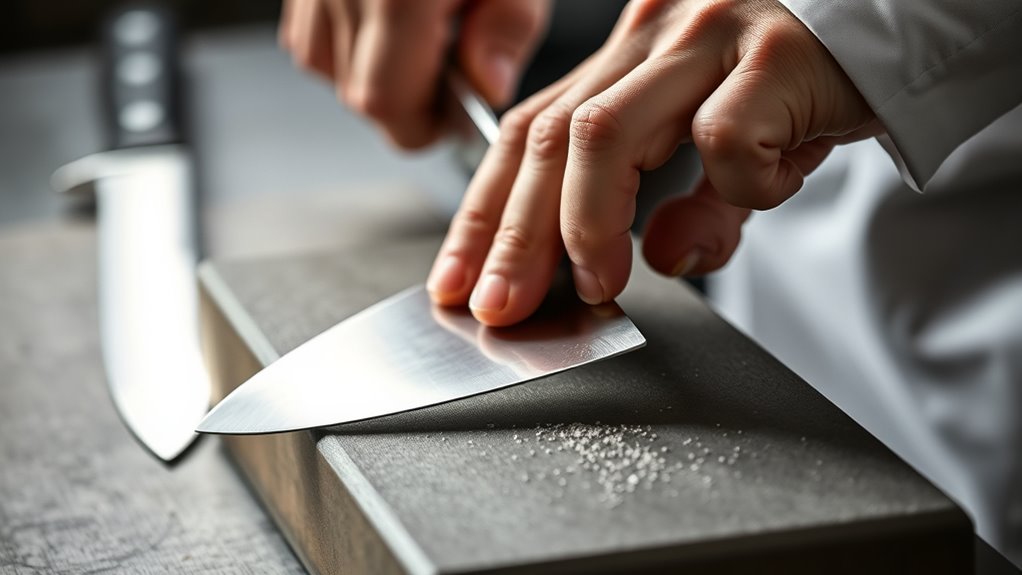
Honing and sharpening serve different purposes in maintaining your knife’s edge: honing realigns microscopic teeth without removing metal, while sharpening grinds away material to create a new edge. Honing can be done frequently, even daily, with simple tools like a steel, whereas sharpening is less frequent and involves more aggressive techniques. Understanding these key differences helps you choose the right process to keep your knives performing their best. Recognizing the importance of exponential growth principles can also enhance your approach to maintaining tools efficiently, especially as technology influences payment processing and other service industries. Additionally, advancements in electric tools have made both honing and sharpening more accessible and precise for home chefs and professionals alike.
Edge Realignment vs. Material Removal
While honing and sharpening both aim to keep your knife cutting effectively, they do so through fundamentally different processes. Honing primarily involves edge realignment, where a honing steel nudges the microscopic teeth of your knife’s edge back into proper alignment without removing metal. This quick maintenance keeps a dull knife sharp and maintains the existing blade shape. Additionally, honing can be performed frequently to maintain a consistent edge, reducing the overall wear on the blade. Conversely, sharpening involves material removal—grinding away metal to create a new, sharper edge when the knife becomes dull or nicks develop. Proper maintenance techniques can extend the lifespan of your blades and reduce the need for frequent sharpening. Additionally, understanding the different methods of sharpening can help you choose the right approach for your specific knives and usage patterns. Regular honing can help you avoid excessive metal removal, preserving your blade’s integrity over time. Moreover, knowing when to hone versus sharpen can prevent premature blade damage and ensure optimal performance of your knives.
In summary:
- Honing realigns the knife edge without removing material.
- Sharpening reshapes the edge by removing metal.
- Regular honing maintains the edge, while sharpening restores cutting ability after dullness or damage.
Frequency and Purpose Differences
Understanding the different frequencies and purposes of honing and sharpening is key to maintaining your knife’s performance. Honing is a quick, routine process usually done daily or before each use to realign the microscopic teeth on your blade edge. Its purpose is to maintain proper knife maintenance without removing metal, ensuring the blade stays sharp and safe. Sharpening, on the other hand, involves removing metal to create a new, sharper edge and is typically done every 6-12 months, depending on usage. The main purpose of sharpening is to restore a dull or damaged blade, extending its lifespan and improving cutting performance. By understanding these differences, you can better schedule honing for regular upkeep and sharpening for deeper blade renewal, keeping your knives in excellent condition. Regular maintenance can also prevent the need for frequent sharpening, saving time and preserving your knives’ integrity.
Tools and Techniques Compared
To effectively maintain your knives, it’s important to recognize the differences in tools and techniques used for honing and sharpening. Honing uses simple tools like a honing steel or rod to realign the microscopic teeth on your knife edge without removing metal. Sharpening, on the other hand, employs sharpening stones or manual/electric sharpeners to grind away metal, creating a new, sharper edge. Incorporating proper Glycolic Acid benefits can also help maintain healthy skin around your hands and improve overall hand care, which is essential when handling sharp tools. Here’s what sets them apart: 1. Honing involves light, controlled strokes to straighten the knife edge. 2. Sharpening requires precise angles and more force to remove metal. 3. The techniques differ: honing maintains, sharpening restores cutting ability. 4. Incorporating proper digital literacy tools can help you learn and improve your sharpening skills effectively. Additionally, understanding the Paint Sprayer Zone can help you select the right tools and techniques for maintaining your equipment efficiently. Recognizing the importance of proper tool maintenance can extend the lifespan of your knives and ensure optimal performance. Understanding these differences helps you choose the right method to keep your knives in top shape.
Choosing the Right Tools for Honing and Sharpening
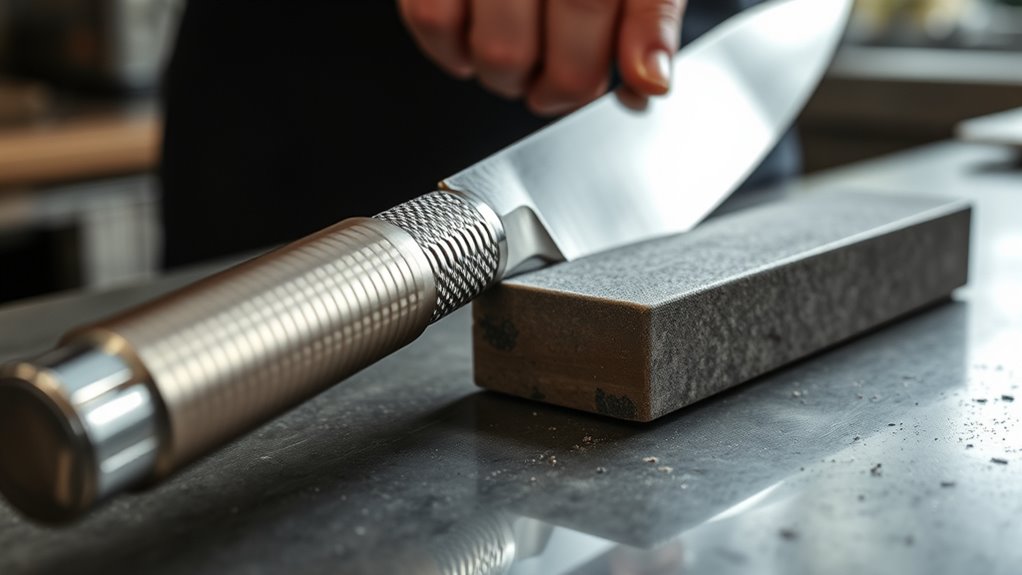
Choosing the right tools for honing and sharpening depends on your knife’s material, condition, and how often you perform maintenance. For regular edge alignment, honing steels—whether diamond or ceramic—are ideal, with diamond steels offering quick realignment and ceramic steels being gentler on delicate Japanese knives. Sharpening stones, like whetstones, are better suited for more thorough blade maintenance and require soaking and proper angle control. They come in various grits, making them versatile for restoring dull edges. Tool selection hinges on your knife’s specific needs; softer blades wear faster with abrasive steels, while high-quality Japanese knives benefit from fine grit whetstones. By choosing the right tools, you guarantee better edge retention and extend your knives’ lifespan.
Signs Your Knife Needs Honing or Sharpening
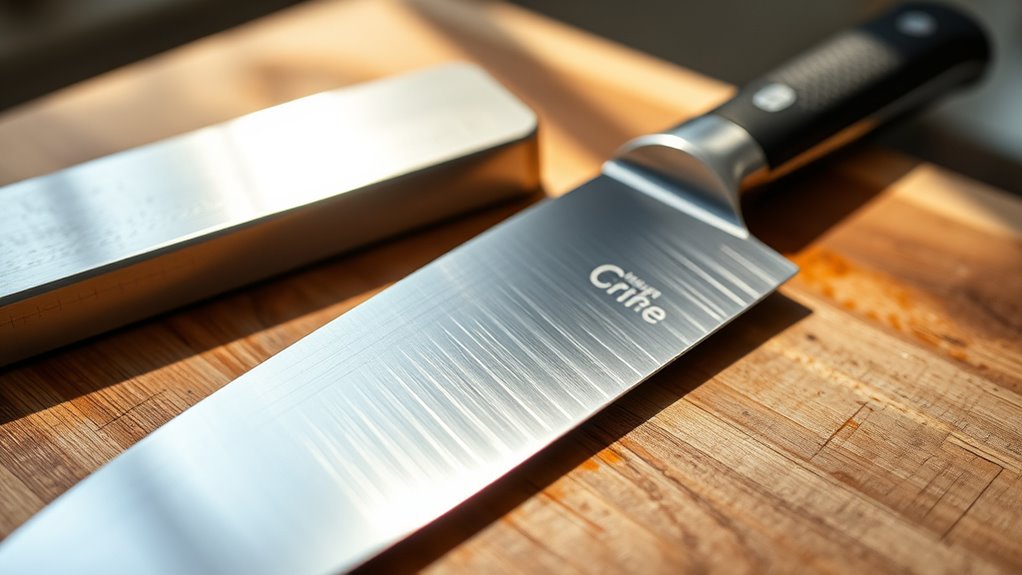
If your knife starts to struggle with cutting tasks or requires more effort, it’s a clear sign that it needs honing or sharpening. You’ll notice your dull knife demands extra force, causing tearing instead of clean cuts, which signals a dull blade. To check your knife’s sharpness, perform the paper test—if the blade struggles to slice effortlessly, it’s time for maintenance. Additionally, if your knife feels loose or wobbly during use, it may be misaligned or dull. Regular use diminishes sharpness, so increased effort or uneven cuts indicate your cutting edge needs attention. Recognizing these signs helps you maintain ideal performance and safety, ensuring your knife remains effective and precise through honing or sharpening. Proper maintenance not only improves performance but also extends the lifespan of your cutting tools, which can be enhanced by understanding the cosmic influences on personal traits that may subtly affect your approach to care. Being aware of relationships dynamics can also help you maintain patience and proper technique during maintenance routines.
Step-by-Step Guide to Honing Your Knife Properly
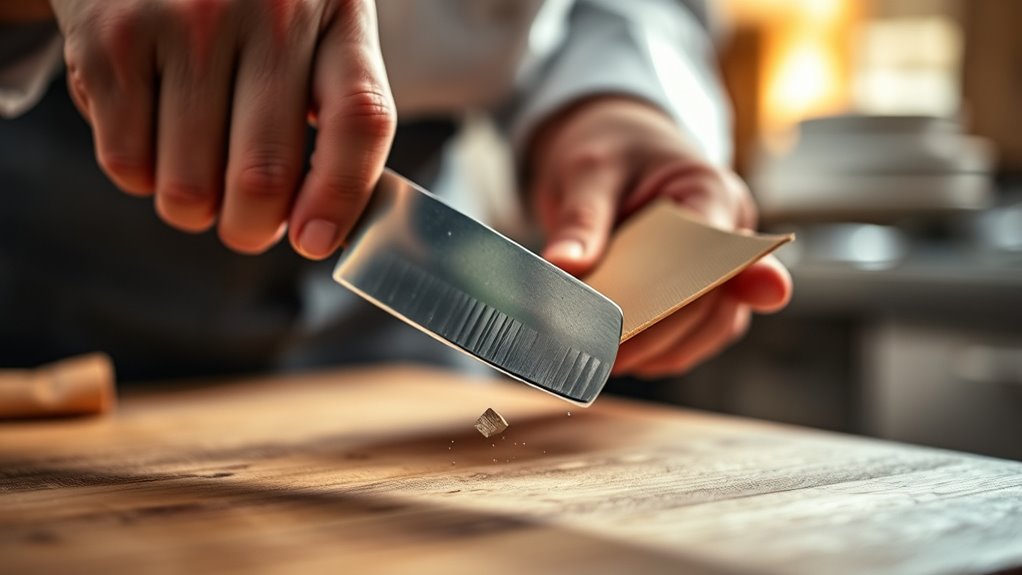
Honing your knife correctly can restore its sharpness without the need for full sharpening. To start, hold your honing steel vertically with a stable base and grip it firmly to prevent slipping. Position your knife at a 15-20 degree angle against the steel, matching the blade’s original bevel. Using proper technique, draw the entire length of the blade down the steel from heel to tip with light, consistent pressure. Maintain the same angle throughout each stroke. Repeat this honing motion 3-6 times on each side of the blade to realign microscopic teeth and improve the knife edge. Proper technique and light pressure are essential for effective honing. Incorporate correct angle techniques to ensure optimal results every time. Finish by testing the knife on paper or a tomato—if it slices smoothly, you’ve honed correctly. Remember, honing is about proper technique and light pressure for effective results.
How to Sharpen Your Knife Safely and Effectively
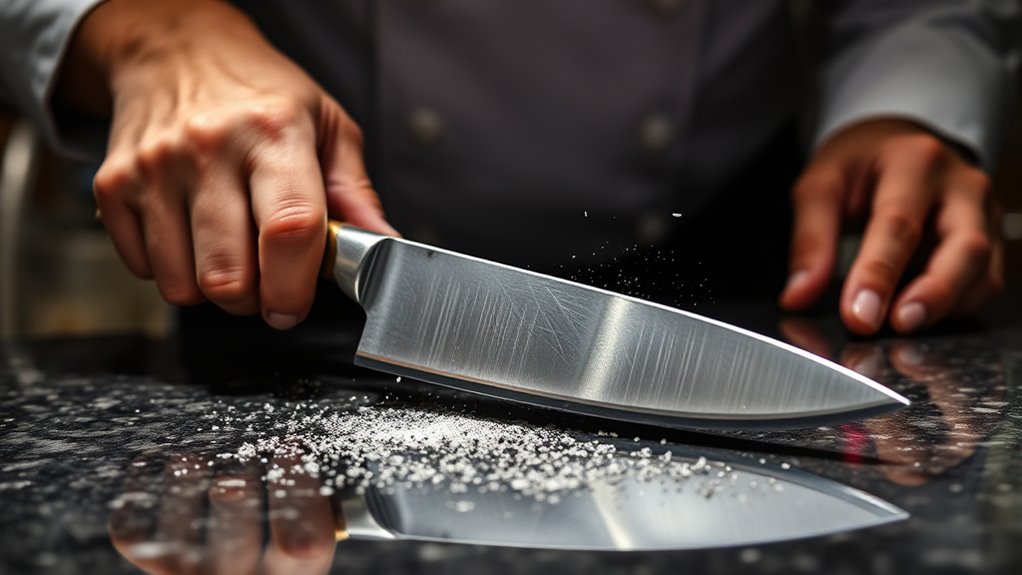
To sharpen your knife safely and effectively, start by choosing the right sharpening tool for your blade. Keep a steady angle of 15-20 degrees and apply gentle, even pressure during each stroke. Test the sharpness afterward to make certain your knife slices smoothly without excessive effort.
Select Appropriate Sharpening Tool
Choosing the right sharpening tool is essential for maintaining your knife’s edge safely and effectively. Start by selecting a sharpening tool that matches your knife’s material and dullness level. For precise control, sharpening stones or whetstones are ideal, but they require soaking in water for 5-10 minutes beforehand. If you want quick results, a pull-through sharpener or honing steel can be effective. Remember to keep your sharpening tools clean to prevent debris buildup. When sharpening, use gentle, consistent strokes—about 10-15 passes per side—and apply moderate pressure to avoid damaging the knife blade. Always follow manufacturer instructions for electric sharpeners or honing steels to ensure safe operation. Proper tool selection helps you achieve a sharp, safe edge with minimal effort.
Maintain Proper Angle
Maintaining the correct angle during sharpening guarantees your knife stays safe and cuts effectively. A proper angle, usually between 15-20 degrees, is key to achieving a sharp edge without damaging the blade. Use an angle finder or sharpening guide to keep a consistent angle throughout the sharpening process. Start from the heel of the blade, gradually moving toward the tip while maintaining the same angle. Apply gentle, even pressure on each stroke to avoid uneven sharpening or chipping. Regularly check your blade’s sharpness and adjust the angle if needed. Staying consistent with your angle helps maintain sharpness longer and ensures safety. By focusing on the proper angle, you optimize your sharpening efforts and extend the life of your knife.
Use Gentle, Consistent Pressure
Applying gentle, consistent pressure while sharpening is essential to prevent damage and extend your knife’s lifespan. Using light pressure ensures you don’t chip or dull the blade edge, while consistent pressure helps achieve an even, sharp edge. To improve your sharpening technique, remember these steps:
- Maintain steady strokes at the proper angle for your knife—about 20 degrees for Western or 15 degrees for Japanese blades.
- Let the sharpening tool do the work; avoid pressing down forcefully.
- Keep a uniform pressure on each side of the blade to create an even, fine edge.
Regularly check your progress with a test cut to confirm you’re applying gentle, proper pressure. This approach guarantees a safe, effective sharpening process.
Tips for Maintaining Sharp Knives Over Time
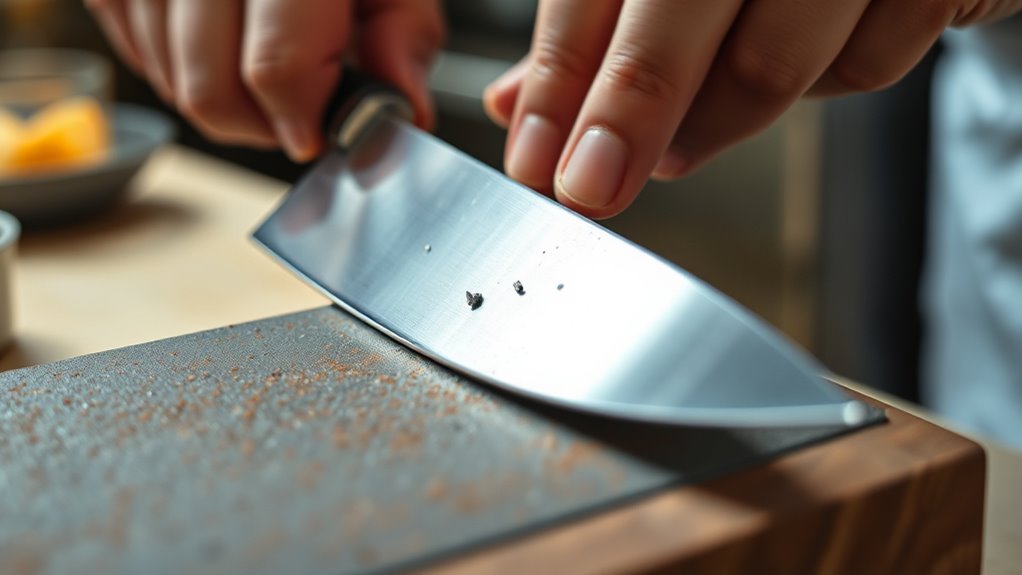
To keep your knives cutting like new, regular honing is essential. Honing helps maintain sharpness by realigning microscopic teeth along the blade edge, preventing dullness. Use a honing steel or ceramic rod with proper technique—maintaining a consistent 10-20 degree angle—to effectively realign the edge. Conduct sharpness tests, like slicing through paper or a tomato, to determine if honing is sufficient or if sharpening is needed. Avoid overusing aggressive sharpening tools; instead, hone frequently to preserve blade integrity. Proper knife storage, such as in sheaths or knife blocks, also protects the edge and extends the time between honing sessions. Consistent knife maintenance ensures your blades stay sharp, safe, and efficient for all your culinary tasks.
Frequently Asked Questions
Is Honing Better Than Sharpening?
You’re wondering if honing is better than sharpening. Honing is gentler, realigning your knife’s microscopic teeth regularly to keep it sharp without removing metal. It’s ideal for routine maintenance and can be done daily. Sharpening, on the other hand, removes material to create a new edge and is necessary only when your knife becomes truly dull or damaged. For ongoing performance, honing is your best choice, but don’t skip sharpening when needed.
Is It Honing or Sharpening Skills?
Imagine you’re preparing a meal and notice your knife isn’t slicing smoothly. You might hone it first with a steel to realign the edge, keeping it sharp. If it’s very dull, you’ll need to sharpen it with a stone to remove metal and restore its edge. So, honing maintains your knife’s performance daily, while sharpening is for when it’s markedly dull. Both skills are essential for proper knife care.
What Is the Best Method of Sharpening Knives?
When choosing the best method to sharpen your knives, consider your blade’s steel and how often you use it. Whetstones give you precise control and last longer, especially for high-quality knives. Pull-through sharpeners are quick and convenient for everyday use but can wear softer steels faster. Electric sharpeners are easy but risk removing too much metal. Combining periodic sharpening with regular honing keeps your knives sharp and durable.
What Does Gordon Ramsay Use to Sharpen His Knives?
Gordon Ramsay uses a high-quality whetstone, typically a 1,000/6,000 grit combination, to sharpen his knives precisely. You should maintain a consistent angle of about 15 to 20 degrees during the process. Ramsay also recommends honing with a steel between sharpening sessions to realign the edge. He prefers professional sharpening tools over electric sharpeners to keep his knives in top condition, combining regular honing with periodic whetstone sharpening for ideal performance.
Conclusion
Keeping your knives sharp isn’t just about safety; it boosts your cooking precision too. Did you know that dull knives can require up to 20 times more force to cut? Regular honing and sharpening maintain that perfect edge, making prep easier and safer. By understanding the difference and following proper techniques, you’ll extend your knives’ lifespan and enjoy better results. Stay consistent, and your kitchen skills will stay razor-sharp for years to come.
